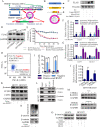Enhancement of TKI sensitivity in lung adenocarcinoma through m6A-dependent translational repression of Wnt signaling by circ-FBXW7
- PMID: 37393311
- PMCID: PMC10314519
- DOI: 10.1186/s12943-023-01811-0
Enhancement of TKI sensitivity in lung adenocarcinoma through m6A-dependent translational repression of Wnt signaling by circ-FBXW7
Abstract
Background: Tyrosine kinase inhibitors (TKIs) that specifically target mutational points in the EGFR gene have significantly reduced suffering and provided greater relief to patients with lung adenocarcinoma (LUAD). The third-generation EGFR-TKI, Osimertinib, has been successfully employed in clinical treatments to overcome resistance to both original and acquired T790M and L858R mutational points. Nevertheless, the issue of treatment failure response has emerged as an insurmountable problem.
Methods: By employing a combination of multiple and integrated approaches, we successfully identified a distinct population within the tumor group that plays a significant role in carcinogenesis, resistance, and recurrence. Our research suggests that addressing TKI resistance may involve targeting the renewal and repopulation of stem-like cells. To investigate the underlying mechanisms, we conducted RNA Microarray and m6A Epi-Transcriptomic Microarray analyses, followed by assessment of transcription factors. Additionally, we specifically designed a tag to detect the polypeptide circRNA-AA, and its expression was confirmed through m6A regulations.
Results: We initially identified unique molecular signatures present in cancer stem cells that contributed to poor therapeutic responses. Activation of the alternative Wnt pathway was found to sustain the renewal and resistant status of these cells. Through bioinformatics analysis and array studies, we observed a significant decrease in the expression of circFBXW7 in Osimertinib-resistant cell lines. Notably, the abnormal expression pattern of circFBXW7 determined the cellular response to Osimertinib. Functional investigations revealed that circFBXW7 inhibits the renewal of cancer stem cells and resensitizes both resistant LUAD cells and stem cells to Osimertinib. In terms of the underlying mechanism, we discovered that circFBXW7 can be translated into short polypeptides known as circFBXW7-185AA. These polypeptides interact with β-catenin in an m6A-dependent manner. This interaction leads to reduced stability of β-catenin by inducing subsequent ubiquitination, thereby suppressing the activation of canonical Wnt signaling. Additionally, we predicted that the m6A reader, YTHDF3, shares common binding sites with hsa-Let-7d-5p. Enforced expression of Let-7d post-transcriptionally decreases the levels of YTHDF3. The repression of Let-7d by Wnt signaling releases the stimulation of m6A modification by YTHDF3, promoting the translation of circFBXW7-185AA. This creates a positive feedback loop contributing to the cascade of cancer initiation and promotion.
Conclusions: Our bench study, in vivo experiments, and clinical validation have unequivocally shown that circFBXW7 effectively inhibits the abilities of LUAD stem cells and reverses resistance to TKIs by modulating Wnt pathway functions through the action of circFBXW7-185AA on β-catenin ubiquitination and inhibition. The regulatory role of circRNA in Osimertinib treatment has been rarely reported, and our findings reveal that this process operates under the influence of m6A modification. These results highlight the tremendous potential of this approach in enhancing therapeutic strategies and overcoming resistance to multiple TKI treatments.
Keywords: Lung adenocarcinoma; Therapy resistance; Translated circRNAs; Tyrosine kinase inhibitor; m6A modification.
© 2023. The Author(s).
Conflict of interest statement
The authors declare no competing interests.
Figures






References
-
- Li Y, Xu Z, Wang S, Zhu Y, Ma D, Mu Y, Ying J, Li J, Xing P. Disease monitoring of epidermal growth factor receptor (EGFR)-mutated non-small-cell lung cancer patients treated with tyrosine kinase inhibitors via EGFR status in circulating tumor DNA. Thorac Cancer. 2022;13:2201–2209. doi: 10.1111/1759-7714.14545. - DOI - PMC - PubMed
-
- Li K, Peng Z-Y, Gao S, Wang Q-S, Wang R, Li X, Xiao G-D, Zhang J, Ren H, Tang S-C, Sun X. M6A associated TSUC7 inhibition contributed to Erlotinib resistance in lung adenocarcinoma through a notch signaling activation dependent way. J Exp Clin Cancer Res. 2021;40:325. doi: 10.1186/s13046-021-02137-9. - DOI - PMC - PubMed
-
- Kashima Y, Shibahara D, Suzuki A, Muto K, Kobayashi IS, Plotnick D, Udagawa H, Izumi H, Shibata Y, Tanaka K, et al. Single-cell analyses reveal diverse mechanisms of resistance to EGFR tyrosine kinase inhibitors in lung cancer. Cancer Res. 2021;81:4835–4848. doi: 10.1158/0008-5472.CAN-20-2811. - DOI - PMC - PubMed
Publication types
MeSH terms
Substances
LinkOut - more resources
Full Text Sources
Medical
Research Materials
Miscellaneous

